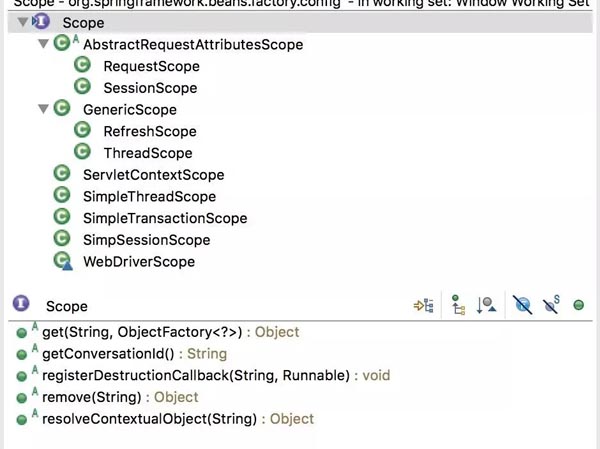您好,登錄后才能下訂單哦!
您好,登錄后才能下訂單哦!
本篇文章為大家展示了Spring Cloud中@RefreshScope的原理是什么,內容簡明扼要并且容易理解,絕對能使你眼前一亮,通過這篇文章的詳細介紹希望你能有所收獲。
@RefreshScope那些事
要說清楚RefreshScope,先要了解Scope
Scope(org.springframework.beans.factory.config.Scope)是Spring 2.0開始就有的核心的概念
RefreshScope(org.springframework.cloud.context.scope.refresh)是spring cloud提供的一種特殊的scope實現,用來實現配置、實例熱加載。
Scope -> GenericScope -> RefreshScope

Scope與ApplicationContext生命周期
AbstractBeanFactory#doGetBean創建Bean實例
protected <T> T doGetBean(...){
final RootBeanDefinition mbd = ...
if (mbd.isSingleton()) {
...
} else if (mbd.isPrototype())
...
} else {
String scopeName = mbd.getScope();
final Scope scope = this.scopes.get(scopeName);
Object scopedInstance = scope.get(beanName, new ObjectFactory<Object>() {...});
...
}
...
}Singleton和Prototype是硬編碼的,并不是Scope子類。 Scope實際上是自定義擴展的接口
Scope Bean實例交由Scope自己創建,例如SessionScope是從Session中獲取實例的,ThreadScope是從ThreadLocal中獲取的,而RefreshScope是在內建緩存中獲取的。
@Scope 對象的實例化
@RefreshScope 是scopeName="refresh"的 @Scope
...
@Scope("refresh")
public @interface RefreshScope {
...
}@Scope 的注冊 AnnotatedBeanDefinitionReader#registerBean
public void registerBean(...){
...
ScopeMetadata scopeMetadata = this.scopeMetadataResolver.resolveScopeMetadata(abd);
abd.setScope(scopeMetadata.getScopeName());
...
definitionHolder = AnnotationConfigUtils.applyScopedProxyMode(scopeMetadata, definitionHolder, this.registry);
}讀取@Scope元數據, AnnotationScopeMetadataResolver#resolveScopeMetadata
public ScopeMetadata resolveScopeMetadata(BeanDefinition definition) {
AnnotationAttributes attributes = AnnotationConfigUtils.attributesFor(
annDef.getMetadata(), Scope.class);
if (attributes != null) {
metadata.setScopeName(attributes.getString("value"));
ScopedProxyMode proxyMode = attributes.getEnum("proxyMode");
if (proxyMode == null || proxyMode == ScopedProxyMode.DEFAULT) {
proxyMode = this.defaultProxyMode;
}
metadata.setScopedProxyMode(proxyMode);
}
}Scope實例對象通過ScopedProxyFactoryBean創建,其中通過AOP使其實現ScopedObject接口,這里不再展開
現在來說說RefreshScope是如何實現配置和實例刷新的
RefreshScope注冊
RefreshAutoConfiguration#RefreshScopeConfiguration
@Component
@ConditionalOnMissingBean(RefreshScope.class)
protected static class RefreshScopeConfiguration implements BeanDefinitionRegistryPostProcessor{
...
registry.registerBeanDefinition("refreshScope",
BeanDefinitionBuilder.genericBeanDefinition(RefreshScope.class)
.setRole(BeanDefinition.ROLE_INFRASTRUCTURE)
.getBeanDefinition());
...
}RefreshScope extends GenericScope, 大部分邏輯在 GenericScope 中
GenericScope#postProcessBeanFactory 中向AbstractBeanFactory注冊自己
public class GenericScope implements Scope, BeanFactoryPostProcessor...{
@Override
public void postProcessBeanFactory(ConfigurableListableBeanFactory beanFactory)
throws BeansException {
beanFactory.registerScope(this.name/*refresh*/, this/*RefreshScope*/);
...
}
}RefreshScope 刷新過程
入口在ContextRefresher#refresh
refresh() {
Map<String, Object> before = ①extract(
this.context.getEnvironment().getPropertySources());
②addConfigFilesToEnvironment();
Set<String> keys = ④changes(before,
③extract(this.context.getEnvironment().getPropertySources())).keySet();
this.context.⑤publishEvent(new EnvironmentChangeEvent(keys));
this.scope.⑥refreshAll();
}①提取標準參數(SYSTEM,JNDI,SERVLET)之外所有參數變量
②把原來的Environment里的參數放到一個新建的Spring Context容器下重新加載,完事之后關閉新容器
③提起更新過的參數(排除標準參數)
④比較出變更項
⑤發布環境變更事件,接收:EnvironmentChangeListener/LoggingRebinder
⑥RefreshScope用新的環境參數重新生成Bean
重新生成的過程很簡單,清除refreshscope緩存幷銷毀Bean,下次就會重新從BeanFactory獲取一個新的實例(該實例使用新的配置)
RefreshScope#refreshAll
public void refreshAll() {
<b>super.destroy();</b>
this.context.publishEvent(new RefreshScopeRefreshedEvent());
}
GenericScope#destroy
public void destroy() {
...
Collection<BeanLifecycleWrapper> wrappers = <b>this.cache.clear()</b>;
for (BeanLifecycleWrapper wrapper : wrappers) {
<b>wrapper.destroy();</b>
}
}Spring Cloud Bus 如何觸發 Refresh
BusAutoConfiguration#BusRefreshConfiguration 發布一個RefreshBusEndpoint
@Configuration
@ConditionalOnClass({ Endpoint.class, RefreshScope.class })
protected static class BusRefreshConfiguration {
@Configuration
@ConditionalOnBean(ContextRefresher.class)
@ConditionalOnProperty(value = "endpoints.spring.cloud.bus.refresh.enabled", matchIfMissing = true)
protected static class BusRefreshEndpointConfiguration {
@Bean
public RefreshBusEndpoint refreshBusEndpoint(ApplicationContext context,
BusProperties bus) {
return new RefreshBusEndpoint(context, bus.getId());
}
}
}RefreshBusEndpoint 會從http端口觸發廣播RefreshRemoteApplicationEvent事件
@Endpoint(id = "bus-refresh")
public class RefreshBusEndpoint extends AbstractBusEndpoint {
public void busRefresh() {
publish(new RefreshRemoteApplicationEvent(this, getInstanceId(), null));
}
}BusAutoConfiguration#refreshListener 負責接收事件(所有配置bus的節點)
@Bean
@ConditionalOnProperty(value = "spring.cloud.bus.refresh.enabled", matchIfMissing = true)
@ConditionalOnBean(ContextRefresher.class)
public RefreshListener refreshListener(ContextRefresher contextRefresher) {
return new RefreshListener(contextRefresher);
}RefreshListener#onApplicationEvent 觸發 ContextRefresher
public void onApplicationEvent(RefreshRemoteApplicationEvent event) {
Set<String> keys = contextRefresher.refresh();
}大部分需要更新的服務需要打上@RefreshScope, EurekaClient是如何配置更新的
EurekaClientAutoConfiguration#RefreshableEurekaClientConfiguration
@Configuration
@ConditionalOnRefreshScope
protected static class RefreshableEurekaClientConfiguration{
@Bean
@RefreshScope
public EurekaClient eurekaClient(...) {
return new CloudEurekaClient(manager, config, this.optionalArgs,
this.context);
}
@Bean
@RefreshScope
public ApplicationInfoManager eurekaApplicationInfoManager(...) {
...
return new ApplicationInfoManager(config, instanceInfo);
}
}上述內容就是Spring Cloud中@RefreshScope的原理是什么,你們學到知識或技能了嗎?如果還想學到更多技能或者豐富自己的知識儲備,歡迎關注億速云行業資訊頻道。
免責聲明:本站發布的內容(圖片、視頻和文字)以原創、轉載和分享為主,文章觀點不代表本網站立場,如果涉及侵權請聯系站長郵箱:is@yisu.com進行舉報,并提供相關證據,一經查實,將立刻刪除涉嫌侵權內容。